Google Pixel 8 Pro Review: More AI tricks and gradual improvements all around
We may earn a commission if you make a purchase from the links on this page.

Google Pixel 8 Pro Intro
Google has a long pedigree in developing complex algorithms, so when the AI craze hit last year, it was barely a surprise that Google was already cooking up features for the latest Pixel 8 Pro. The new Magic Editor that lets you reframe your photos and remove objects, with generative AI working to "redraw" the pixels that end up missing. Audio Eraser gets rid of wind noise and other annoying sounds from recordings. Summarize audio recordings, rephrase your texts, filter out spam calls, or have the AI pick up for you and give you a summary of the reason for the other person calling. There are a lot of little smart features that may improve your day-to-day and brings the Pixel 8 Pro closer to being a personal assistant.
But let's not forget that Google's favorite AI tricks are not the only new thing here. You have upgraded cameras that can now shoot in full 50MP resolution, you have the brightest display we have ever seen, and you have a new Tensor chip that aims to close the gap with Snapdragon and Apple chips. Oh and did I mention that Google just completely reimagined its software update commitment? This new Pixel gets a promise for SEVEN years of software updates! Unprecedented!
This review is written after I spent about a week daily driving the Pixel 8 Pro, and spoiler alert: I like Pixel phones and this is the best one yet. But those new AI features... I have some mixed feeling. Let me explain!
*Disclaimer: You may notice review scores have changed on PhoneArena! Since September 20th, we have started using a new scoring system. Learn more about the new PhoneArena Smartphone Review Rating system here.
As you can see above, the Pixel 8 Pro total review score is lower than you might expect. That is not because the phone is flawed in some unexpected ways, but because we have implemented a new rating system at PhoneArena that gives readers a better idea of the performance of a phone across different categories. Remember to look at the scores and compare them to the average for the class, and we belive you will find these scores tremendously useful. Learn more about the new PhoneArena Smartphone Review Rating system here.
We ran the Pixel 8 Pro through our full reviewing process, testing the camera, battery endurance, hardware performance, and overall behavior of the phone. We experimented with the unique elements like the AI editors, Video boost, and Best Take, and we took note of how the unique Tensor G3 chip steps up to the task of powering a modern day flagship phone. Here's our full review of the Google Pixel 8 Pro:
What’s new about the Pixel 8 Pro
- New Tensor G3 system chip
- The brightest screen ever on a Pixel
- Upgrades across all cameras
- Up to 1TB of storage
- 7 years of Android OS updates (yes, really!)
- A thermometer (of all things)
- $100 higher starting price
- AI tricks/gimmicks like Magic Editor, Best Take, and Audio Magic Eraser
Table of Contents:
Also read:
Google Pixel 8 Pro Unboxing
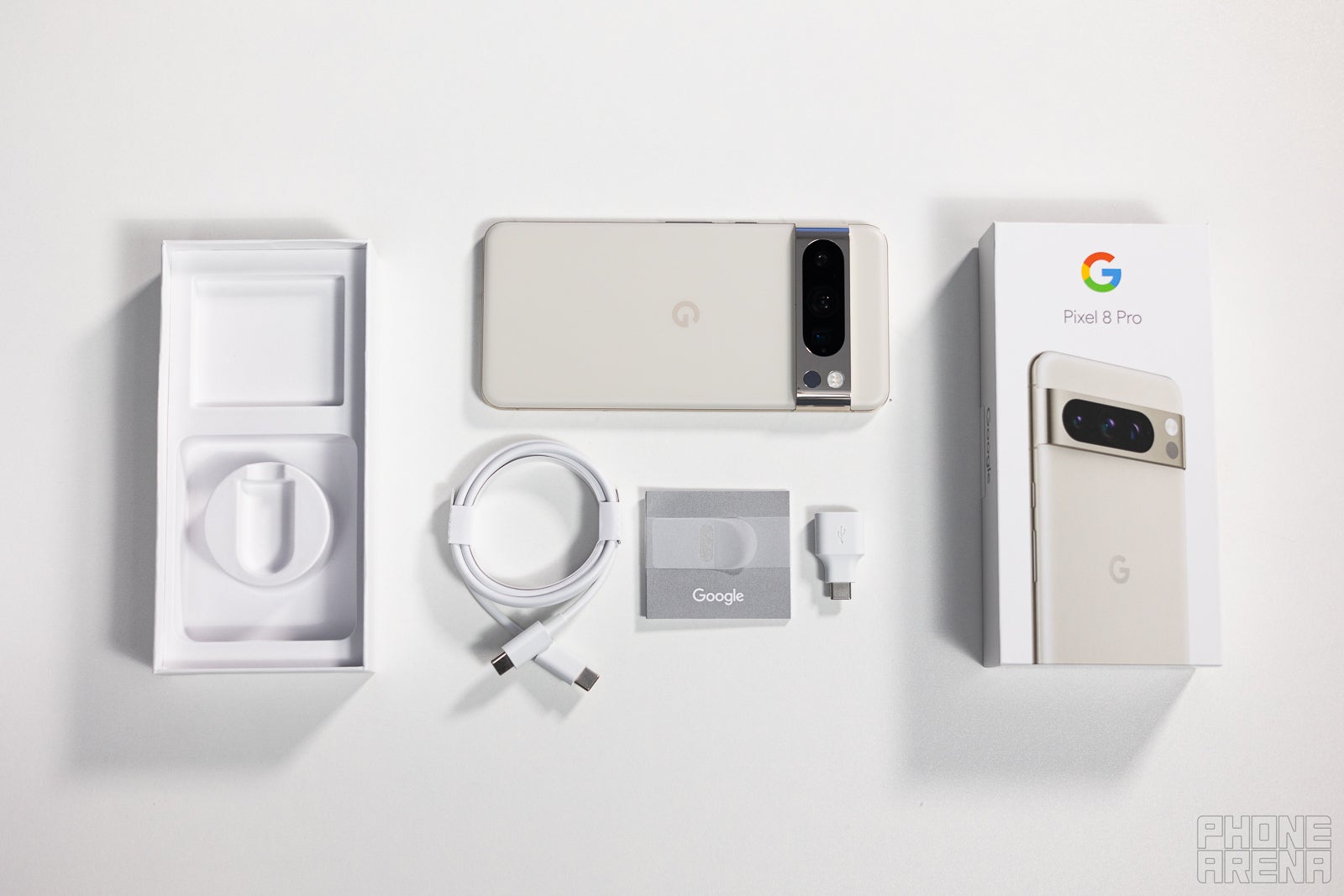
Pixel 8 Pro what is inside the box (Image credit - PhoneArena)
First things first, the Pixel 8 Pro ships with a slim box which immediately tells the trained eye that you won't find a charging brick inside.
What you do get is a white USB-C to USB-C cable, a SIM tool, an adapter for data transfer, as well as user manual. Oh, and the phone of course!
Google Pixel 8 Pro Specs
Notable upgrades on the Pixel 8 Pro specs sheet include the brighter OLED display, the new Tensor G3 system chip, and, as Google describes it, "a fully upgraded pro-level triple rear camera system". While the battery capacity is more or less the same as last year, the charging speed has been bumped from 23 to 30 watts.
| Specs | Google Pixel 8 Pro |
|---|---|
| Size and Weight | 162.6 x 76.5 x 8.8mm 213g |
| Display | 6.7" OLED 1344x2992 pixels 1-120Hz, 2400 nits max brightness |
| Processor | Google Tensor G3 Samsung 4nm LPP |
| RAM, Storage and Price | 12/128 GB for $999 12/256 GB for $1,059 12/512 GB for $1,119 12/1 TB for $1,219 *LPDDR5X RAM |
| Software | Android 14 |
| Cameras | 50MP main *1.2um pixels 48MP ultrawide *0.8um pixels 48MP 5X zoom *0.7um pixels 10.5MP selfie *1.22um pixels |
| Battery Size | 5,050 mAh |
| Charging Speeds | 30W wired 23W wireless |
Google Pixel 8 Pro Design & Colors
Mostly the same looks, but the new blue color is lovely
As the saying goes, if it ain't broke, don't fix it. Google's design language is in full force with the Pixel 8 Pro, with the signature camera strip at the back making it clear this ain't no Galaxy or iPhone. In other words, Google's new best phone looks and feels a lot like the 7 Pro.
A minor difference is the switch to matte finish for the edgeless Gorilla Glass Victus 2 back. It is paired with a polished, color-matched frame made of 100% recycled aluminum. While the Pixel 8 Pro skips on the titanium and stainless steel trends, it is lighter than rivals like the iPhone 15 Pro Max or the Galaxy S23 Ultra. It feels great to hold and, as I got used ot handling it, I found that it's a habit to prop it up by resting my index finger against that camera bar on the back. It actually improves the grip feel.
For the Pixel 8 Pro you have three colors to pick from:
- Bay – a cheerful shade of light blue
- Porcelain – a light beige color we know from the Pixel Tablet
- Obsidian – the color closest to black you can get this year
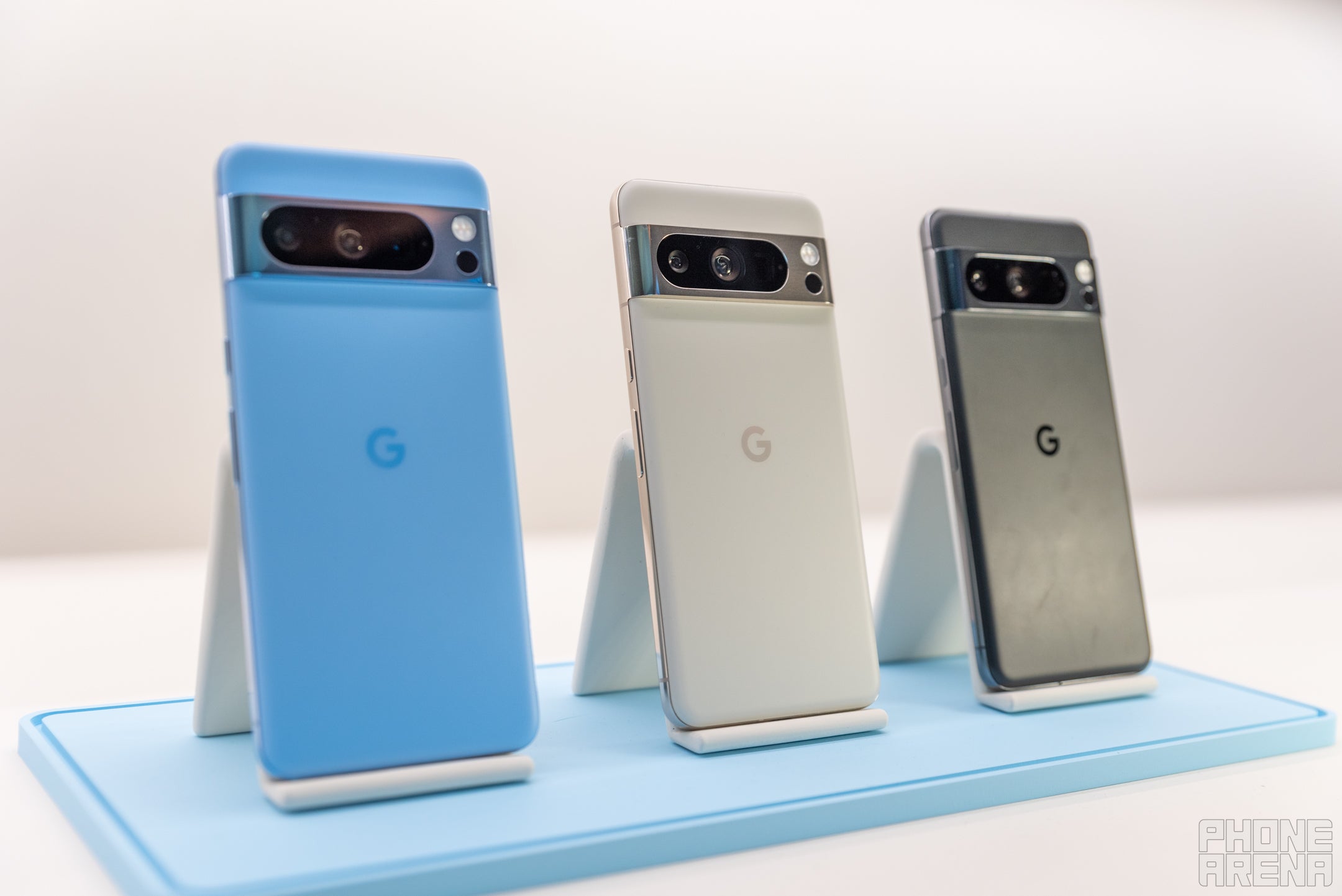
Pixel 8 Pro comes in three colors (Image credit - PhoneArena
It is nice of Google to offer color-matching cases, Pixel Watch 2 Bands, and even Pixel Buds Pro, regardless of which Pixel 8 Pro color you pick.
The Pixel 8 Pro is IP68-certified, much like most other phones of its category. This means it is protected against dust and water ingress at a depth of 1.5 meters (5 feet) for 30 minutes. And if it breaks, Google has partnered with iFixit to provide parts, tools, and guides to anyone who wants to repair their Pixel 8 Pro at home, DIY style.
Google was in no haste to add titanium to its flagship build — not bothered to chase after the iPhone 15 Pro's new premium material. We don't count this as a negative — better do things right, instead of doing them in a hurry. When it comes to unique elements — the iPhone 15 Pro has an Action Button, the Galaxy S24 Ultra has an S Pen, and the Pixel 8 Pro has a... thermometer. Which is kind of OK, we guess, but not extremely useful — more on that below.
Google Pixel 8 Pro Display
Super Actua Display – that's one we haven't heard before. It's the fancy name for the 6.7-inch LTPO OLED display that the Pixel 8 Pro is rocking.
In case you're curious, Actua does not refer to a single display feature. Rather, it encompasses a set of qualities which together aim to provide real-life clarity. The screen supports 1-120Hz variable refresh rate, while a brightness of 1600 nits HDR/2400 peak enables it to display Ultra HDR images even in direct sunlight. This is a record breaking number, just keep in mind that the phone can only stay that bright for a few minutes before dimming back to lower numbers.
Keep in mind that our brightness numbers are slightly different than the official figures because we use a different method of measuring brightness (at 100% white). For all the rest, color calibration and balance are about the same as the previous model. However, a result north of 1,400 nits is still very, very good — it basically ensures that you will be able to read your emails even with the sun blasting straight on the display.
The minimum brightness of 1.9 nits is really, really dim but some people prefer to see it even lower for comfortable bedside viewing. Depends on how sensitive you are.
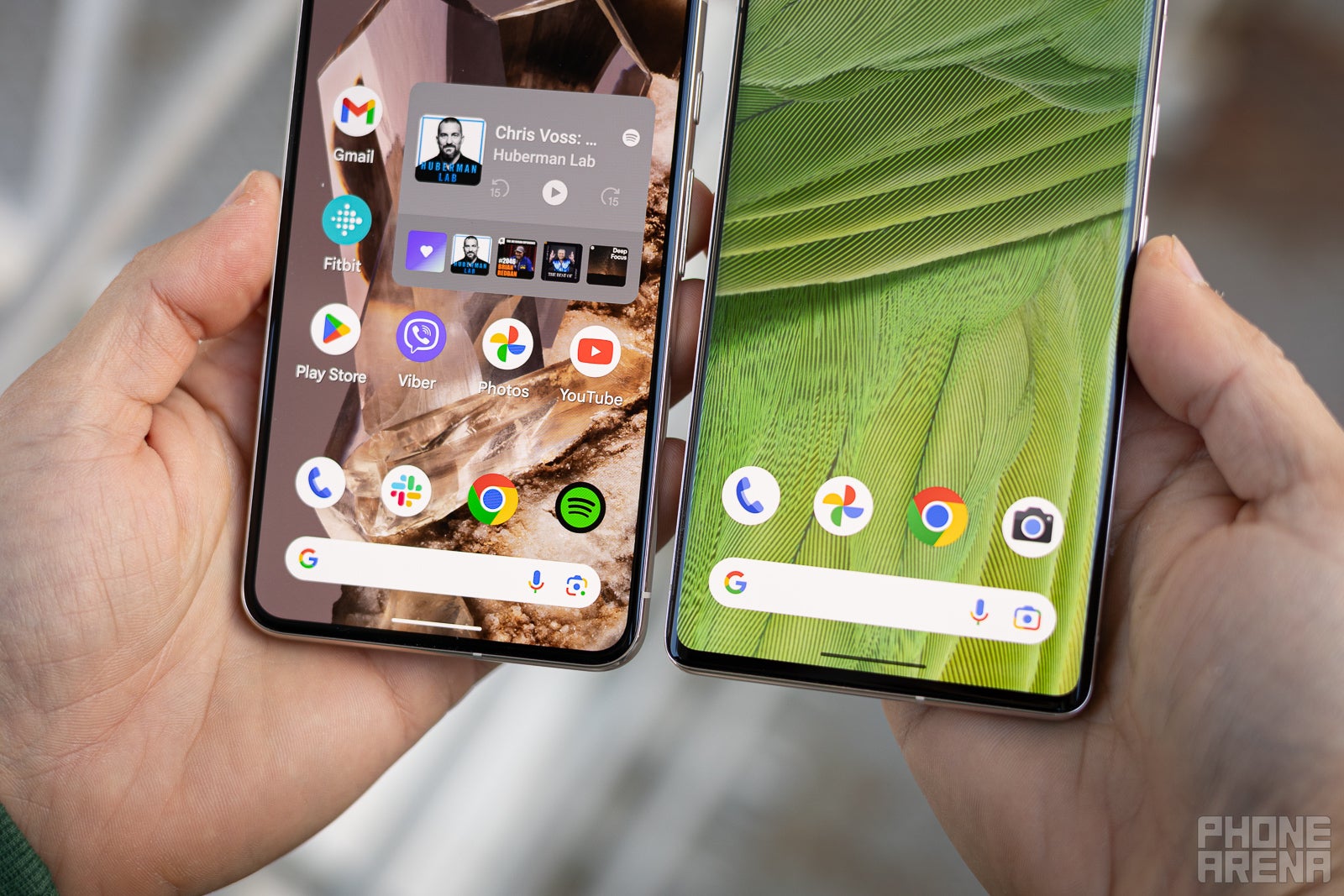
Pixel 8 Pro on the left, Pixel 7 Pro with a curved screen on the right (Image Credit - PhoneArena)
Oh, and did I mention that the screen on the Pixel 8 Pro is now completely flat! That's good news in our books, and you can also see that "chin" bezel on the bottom has been reduced, so the phone looks a bit more stylish than before.
Under the display is a fingerprint reader of the optical kind (yes, the one that can kind of blind you at night), and its performance felt very similar to the Pixel 7 Pro. That is to say decent and with dependable accuracy, but just a bit slower or on-point than the Galaxy S23 series or other Android flagships. Face unlock is available as well, and it still uses a 2D image, but now the AI algorithm is considered more secure, and you can use it with banking apps, which is convenient.
The iPhone's Face ID is still king when it comes to unlocking stuff by just looking at the phone — it's secure and incredibly fast, plus, it's convenient as you don't need to change phone grip or anything. Just lift the device and it's unlocked, tap the "get app" button and it's downloaded — no need to change phone grip or anything. And, for fingerprint scanners, Samsung's ultrasonic scanner is very good specifically because it can go through some moisture or particles between your finger and the glass — optical fingerprint scanners, like the one on the Pixel 8 Pro, will fail due to the smallest of obstructions.
Google Pixel 8 Pro Camera
Hardware upgrades and new software features for extra versatility and creativity
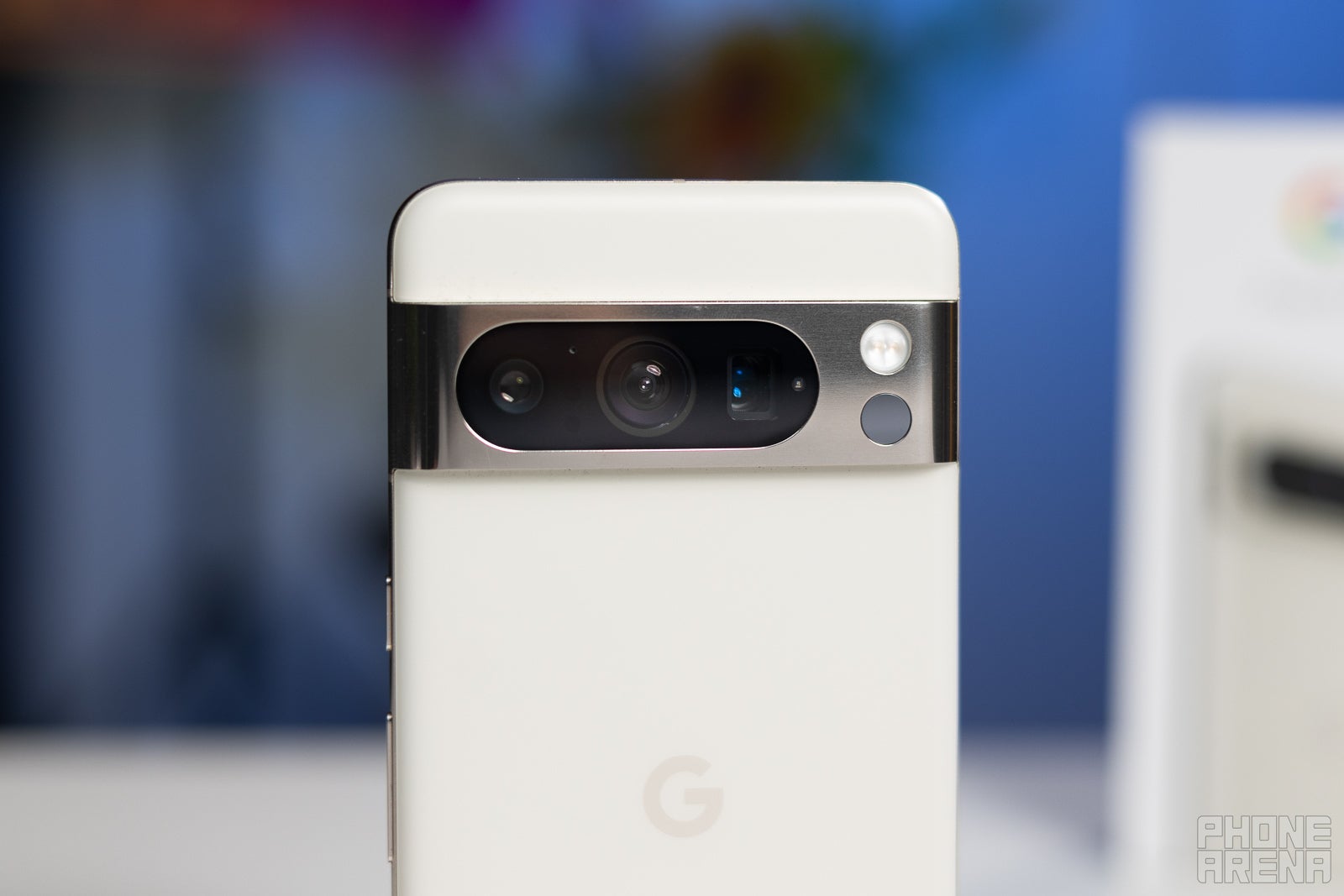
You now have a singular and much bigger camera cutout (Image credit - PhoneArena)
Our camera benchmark breaks down and measures each of the aspects of using a phone camera. From the convenience of the options, to viewfinder preview quality, to actual quality of the output. The Pixel 8 Pro is up among the very best — a 148 total score is nothing short of great, and only a few points away from the current best, which is the Xiaomi 14 Ultra right now. While the Pixel 8 Pro doesn't hit any top score in any of the sub-categories, it performs reliably well in each one. The only place where it's lacking is when recording video with its zoom camera specifically — it got 17 points there, almost 30% less than the current best, which is 24.
You can learn more about our PhoneArena Camera Score testing protocol here.
The 48 MP ultrawide camera gathers 105% more light and focuses 30% closer for improved Macro Focus shots. The 48MP telephoto lens gets a 56% boost in light sensitivity and provides 5x optical zoom. 10x optical-quality sensor-crop zoom is also an option. The 10.5MP selfie camera has autofocus now, which is neat.

Pixel 8 Pro camera app now has totally separate photo and video modes
So has image quality changed when using the good old regular shooting modes and not AI?
Well, you can see the comparisons right here:
Or you can just glance at the sample photos we captured with the Pixel 8 Pro in various conditions and using all of the cameras.
Pixel 8 Pro Camera Samples
The annoying lens flare issue (a blurry spot on the image next to lights at night) is gone on the Pixel 8 Pro, and overall images are just a bit better all around compared to the previous model.
For some reason, however, Google just cannot fix the terrible looking Portrait Mode shots. That's been a persistent issue in the last few generations of Pixel phones, and Portrait Mode photos on the Pixel 8 Pro range from slightly bad to just-delete-this-image immediately. At this point, it feels smarter to just take a regular picture and apply a background blur as an edit afterwards in Google Photos.
Oh, all the above shots were captured at the default 12MP resolution, but you now finally get a Pro mode and you can also shoot images at the full 50MP resolution of the main camera, and you can shoot either a JPEG or a RAW file. The reason to do that is of course the cleaner detail, which may come at the expense of some noise at night. For some special shots, this could be worth it, but detail is already quite good of these 12MP shots, so you are not missing out on too much if you stick with the defaults. Still, it's nice having that option.
But what's truly exciting is the inclusion of AI-powered image and video editing features like Magic Editor, Best Take, and Audio Magic Eraser. Later on in December, Google is going to release a feature drop adding Zoom Enhance and Video Boost with Night Sight. Here's what all these do:
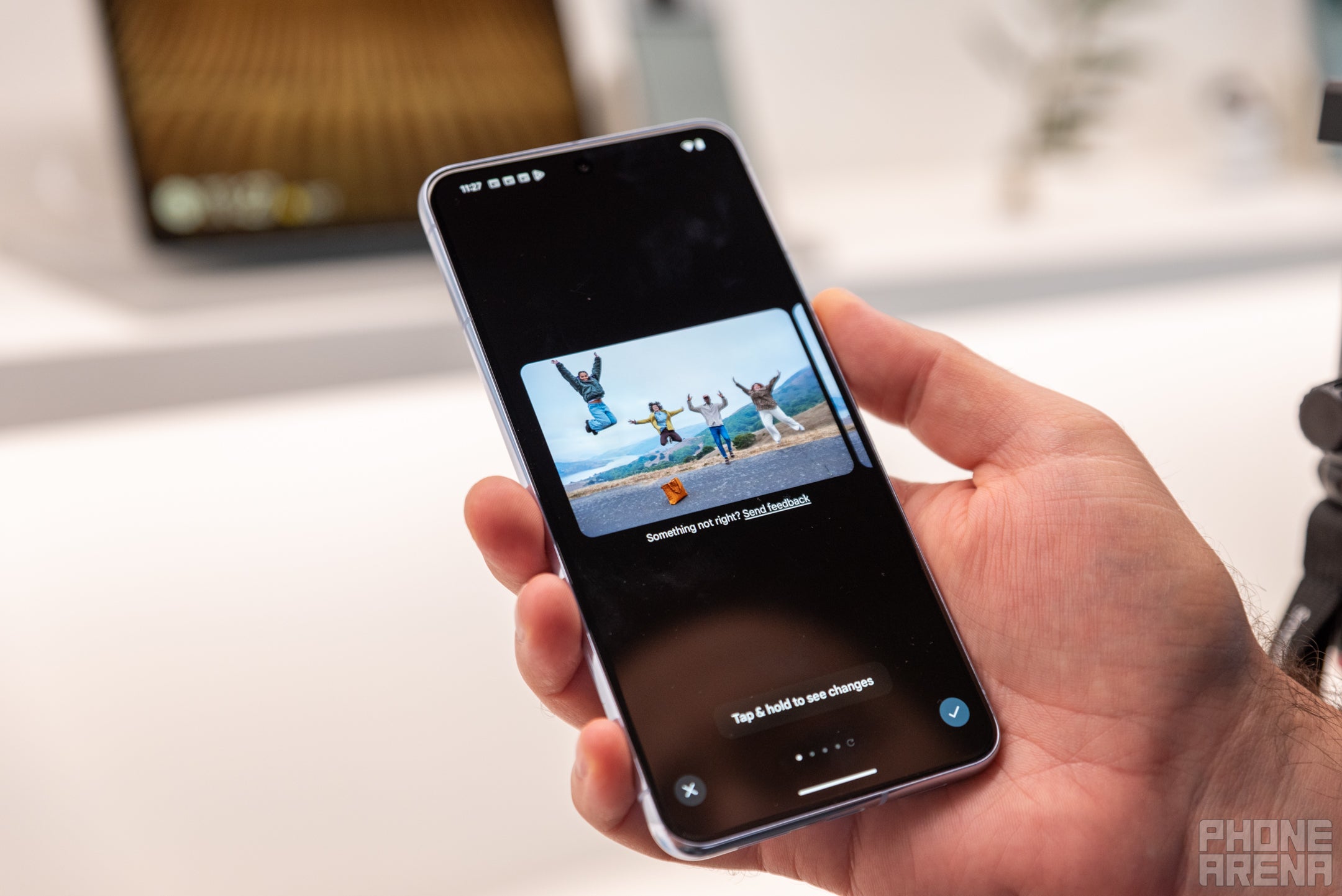
Magic editor allows you to move and resize objects
- Magic Editor – announced earlier in 2023, this new feature leverages generative AI to enable next-level image editing. You can move, resize, or delete objects or people in the shot. Replacing the sky is also an option if you feel like it.
- Best Take – this is a feature designed specifically for group shots, the goal being to get a photo where everyone looks their best. For it to work, you need several takes of the same scene. Best Take then analyzes all available takes and lets you replace any face with one from a different frame.

Audio Magic Eraser reduces noise in videos
- Audio Magic Eraser – a feature that separates different sound types, such as noise, music, and speech. You can then adjust their volume individually.
- Zoom Enhance – Coming in December of 2023, this feature delivers the kind of zoom enhancements you'd typically see in the movies. It intelligently sharpens details in images using generative AI.
- Video Boost – This is a new kind of video processing from Google. If enabled, this will upload your video to Google's servers for processing. After a while, we get a video with improved dynamic range, colors, and detail in any light. Using Video Boost in low light also enables Night Sight for Video for brighter, clearer low-light videos. The bad news is that it's pretty hard to export and share a Video Boosted clip outside of the Google Photos platform.
Video Quality

The Pixel 8 Pro brings a few significant improvements to video quality, but the one we are most happy to see is that the lens flare issue from the previous model is fixed. Videos even at night look clean and stable, and the 5X zoom camera does an excellent job and we would say it's less noisy than the one on the iPhone 15 Pro Max, but on the downside, it has just slightly less capable stabilization.
At the same time, a few very important video recording options are still missing. On our US Pixel unit, we could not find a way to record PAL videos (meaning recording at 25/50fps rather than 30/60fps). That's frustrating for frequent travelers as videos they record will have a visible flicker when pointed at lights, and also most other high-end phones offer this option.
The Pixel 8 Pro camera trades punches with the Galaxy S24 Ultra and iPhone 15 Pro Max. It's probably, maybe, slightly below them if you pixel-peep and compare multiple photos side by side, but, in general, it does not disappoint. With video, it can do with some improvement to stabilization, especially when the lights go down — the iPhone 15 Pro still reigns in that aspect. But AI tricks suck as Video Boost and Best Take are quite an interesting spin, and still mostly unique to the Pixel 8 Pro (we suspect — not for long).
Google Pixel 8 Pro Performance & Benchmarks
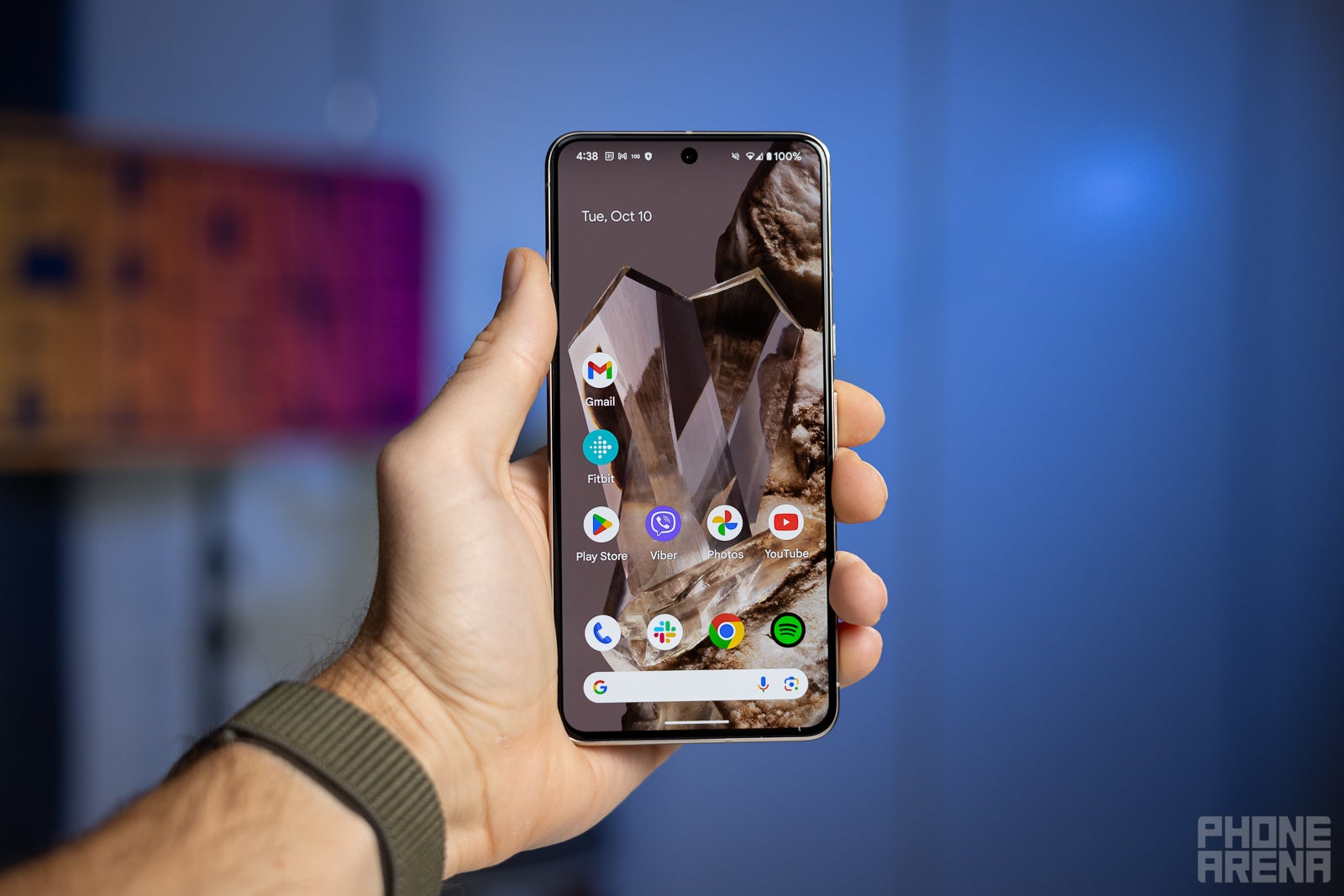
There's a new Tensor G3 chip inside the Pixel 8 Pro, paired with 12GB of RAM.
Tensor chips have never stood out with raw processing power, typically lagging behind Qualcomm's best Snapdragons and Apple's A-series chips. But the Tensor series is optimized for performing AI tasks faster, and with the Tensor G3, Google aims to bring more of the required AI computations on device, generative AI included, instead of relying on computing in the cloud. The chip also comes with the latest generation of ARM CPUs, an upgraded GPU, and a new ISP and Imaging DSP.
The new Tensor G3 provides a nice upgrade in speed over the G2. On CPU-focused GeekBench 6, the Tensor G3 scored around 20% more than the G2 in single core speeds and nearly 30% more in multi-score. If you are a specs geek, you should also know that this chip seems to be built on Samsung's 4nm LPP process, which is just a beat behind the one used by the Snapdragon chips.
And the Tensor G3 is still not quite at the performance of the Snapdragon 8 Gen 2, which powers most other Android flagships. The Snapdragon chip is 15% faster in single-core speeds and some 17% faster in multi-core tasks, and the Apple A17 Pro chip is even speedier.
For games, the Pixel 8 Pro delivers a nearly 30% faster performance and throttles gradually, losing more significant power after 10 minutes of gaming. In the 3D Mark Extreme stress test which runs for 20 minutes and shows the prolonged performance of a GPU, the Pixel 8 Pro scored nearly 25% faster than the previous generation. And yes, it still can get a bit on the warmer side, in case you were wondering.
There are four Pixel 8 Pro storage options to pick from. The base 128GB model may be the cheapest at $999, but we'd recommend spending an extra $60 and getting the 256GB variant instead. 512GB and 1TB options are also available for $1,179 and $1,399, respectively.
In general, the Tensor G3 in the Pixel 8 Pro can't stand up to the iPhone 15 Pro's Apple A17 Pro, nor can it touch the Qualcomm Snapdragon 8 Gen 2 or Gen 3 in the Galaxy S23 and Galaxy S24, respectively. Google is not interested in chasing the super-performance category, nor in making a "gaming phone", it seems — it's much more invested in home-baking its chip to fit its AI and Google Assistant needs. And we can respect that.
Pixel 8 Pro Thermometer
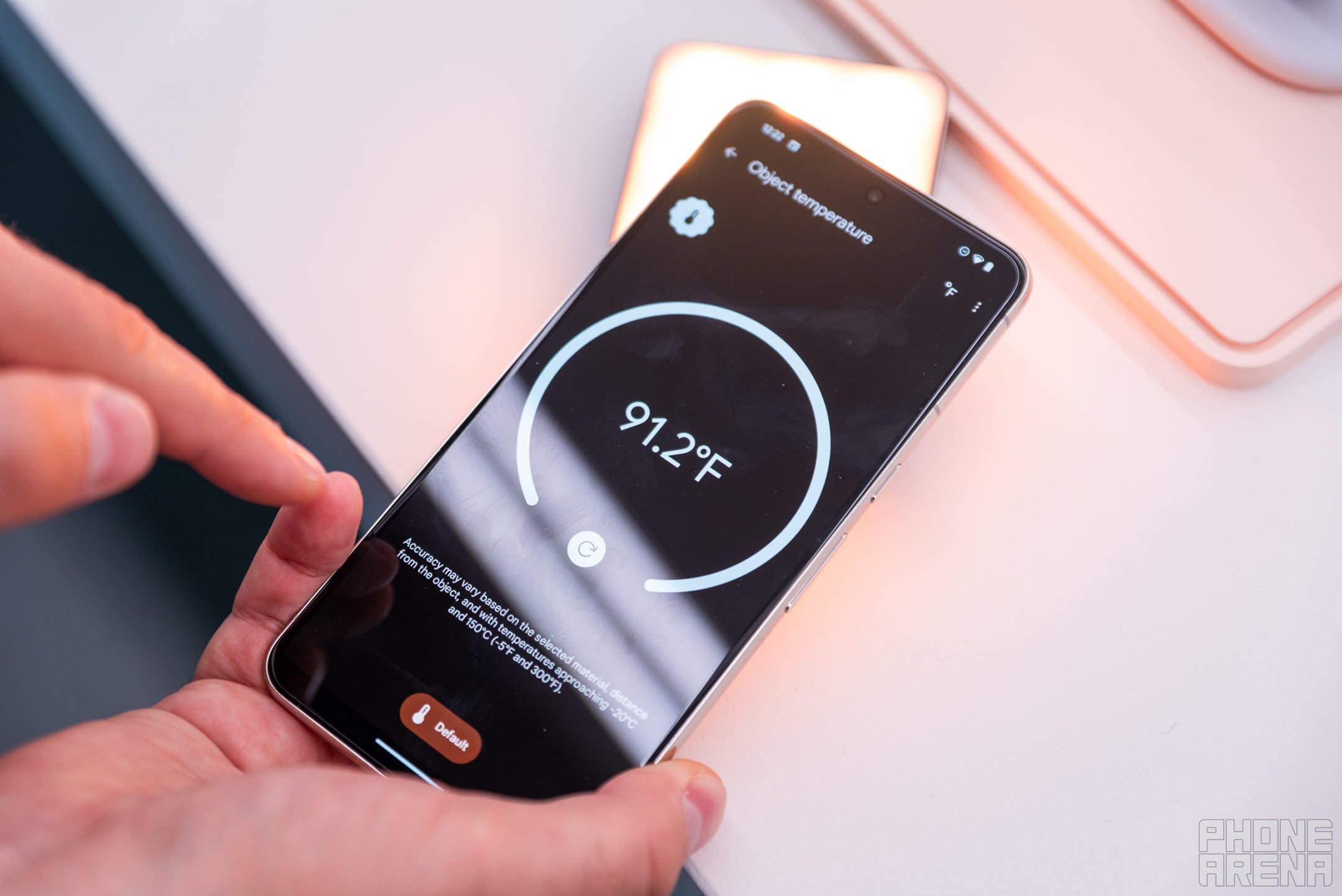
The Thermometer app on the Pixel 8 Pro (Image credit - PhoneArena)
This one's a quirk, definitely, and to be honest, I did not find a single good use for a thermometer. In a poll we ran, 55% of 1,300 respondents say they don't need a thermometer on their phone, so it's definitely not a super popular feature, but still 45% said they would like to have one and it could have its uses in certain situations.
The thermometer (an infrared one) on the Pixel 8 Pro is positioned on the back, under the LED flash. It can measure the temperature of objects from a distance of about 5cm or 2 inches. The sensor works best within a range of -20 C to 150 C (-5F to 302F) and peaks at 200C (392F). This makes it suitable for checking the temperature of surfaces, foods or beverages, though it is important to pick the correct object type setting to get an accurate reading.
It's also frustrating that in the Thermometer app, you don't get a visual indication of whether that infrared beam has hit the exact spot you need, so if you are trying to measure a tiny object, chances are you can easily miss it. And remember: measuring body temperature is NOT an option at this time – a pending FDA approval is expected to allow that. And with such close range, we definitely don't recommend stunts such as measuring the temperature of a fireplace! Overall, I'm not sold on this at all, but your mileage may vary.
Google Pixel 8 Pro Android version
Android 14 is the name of the game here with the Pixel 8 Pro. The latest Android release brings along a number of new and exciting features, including more customization options and support for Ultra HDR photos.
Generative AI wallpapers – This feature draws an entirely new and unique wallpaper following a set of text instructions. No art skills required!
You don't have complete freedom, unfortunately, probably to prevent AI from blushing from certain inevitable requests. There's a limited number of scenes, styles, objects and materials you can mix, and the text input cannot be in free form. Still, this one's a lot of fun to play with.
As for Ultra HDR photos, they contain extra information that allows for brighter, more realistic highlights to be shown. Images should appear as regular JPGs to devices that may not be able to display the additional data properly, which maintains broad compatibility.
Our Android 14 review goes deeper into the details, so check that out too.
New AI features for Pixel 8 Pro from December feature drop:
- Audio record meetings and get a summary of them
- Auto reply and text rephrasing options
- Edit old Portrait photos with studio light; unblur old photos
- A new Video Boost feature - upload the clip to Google's servers to process it (increases dynamics and sharpness)
- Remove coffee stains from scanned documents
- Call screening can answer the call and also relay your reply to caller
Google promises support for the Pixel 8 series for the next wait for it... 7 years! That's an industry-leading figure and a major jump from the 3-5 years we're used to be promised. This means the Pixel 8 Pro will get Android OS updates, security patches, and feature drops all the way through 2030. Of course, we have to remember that Google is also known for killing some beloved apps way before anyone expects, so do take that commitment with some shade of doubt. But to be honest, we do hope all other Android phone makers take notice and follow suit.
Google Pixel 8 Pro Battery
Solid battery life, but not quite in 2-day territory
Google says the Pixel 8 Pro lasts over 24 hours between charges – not bad, but nothing extraordinary given the phone's 5050mAh battery. The capacity is practically identical to what's offered by other top-tier Android phones, including the Galaxy S23 Ultra and last year's Pixel 7 Pro.
Enabling Extreme Battery Saver stretches the number up to 72 hours, but this mode reduces the phone's performance and functionality, so having it on all the time isn't practical. Use that only when you really have to.
PhoneArena Battery Test Results:
In about a week of using the phone, I was satisfied with the battery life I was getting (unlike my experience with Google's new smartwatch, by the way, learn more about that in our Pixel Watch 2 review).
The Pixel 8 Pro got me through a day of even more intense use, and usually around a day and a half.
In our YouTube video streaming test, for example, you can see it outperforms the competition easily, but on the lighter web browsing test it has worse scores. Overall, think somewhere around 7 hours of screen time, give or take, which we would say is just a bit worse than an iPhone 15 Pro Max or Galaxy S23 Ultra, but not by much.
Google says you get faster, 30W charging speeds on the Pixel 8 Pro, which beats the 23W speeds of the predecessor and also the iPhone 15 Pro Max, but is slower than all other Android rivals.
However, we noticed that in regular room temperature, the phone would sometimes get warm and slow down the charging significantly. When placed in a colder spot, it cools down and charging speeds go back up, but that is definitely something to keep in mind.
However, we noticed that in regular room temperature, the phone would sometimes get warm and slow down the charging significantly. When placed in a colder spot, it cools down and charging speeds go back up, but that is definitely something to keep in mind.
We measured a 26% top-up for the Pixel 8 Pro in 15 minutes, while in 30 minutes we got to 47%, close to Google's claims that it can hit 50% in half an hour. That is the same rate as the Pixel 7 Pro, in case you were wondering. And a full 1-100% charge takes 1 hours and 31 minutes, only slightly faster than its predecessor.
PhoneArena Charging Test Results:

The Pixel 8 Pro has a 5,050mAh battery (Image by PhoneArena)
Wireless charging peaks at 23W, but only if you use Google's own Pixel Stand (2nd gen). We guess that has to do with heat again, and the Pixel Stand 2nd Gen does come with a built-in fan.
PhoneArena Wireless Charging Test Results:
You'll be getting only up to 12W speeds with regular Qi chargers that support EPP (Extended Power Profile). As expected, reverse wireless charging is also available.
Google Pixel 8 Pro Competitors and Verdict

With its large screen size, extensive set of camera capabilities, and a starting price of $999, the Pixel 8 Pro is going against rivals like the Galaxy S23 Ultra and the iPhone 15 Pro Max. Both of these are great phones by brands with loyal following, so attracting buyers to join team Google will be quite the challenge.
Still, Google's best phone yet offers an impressive set of features, specs, and exclusive extras at a competitive price. It's in a good position to end up in many buyers' shopping carts this holiday season – so long as no software glitches or hardware issues don't spoil the latest Pixel phone launch, and based on our experience so far, we haven't seen anything troubling.
As for the new AI tricks, they are neat little improvements, but would you really buy a new phone because it could swap a face on a picture? The thermometer is another addition that a large majority of people won't care about. But the overall gradual improvements - the faster speed, the improved camera quality, and the brighter screen - are the feature that stand out the most. And of course, talk about setting a new standard with software updates! Seven years!
At the end of the day, the Pixel 8 Pro is about gradual improvements to a device that has been one of the top three phones out there. It's an easy recommendation. However, there is still no one big new feature to really stand out and Google might need something big to convince Galaxy users and iPhone users to switch.

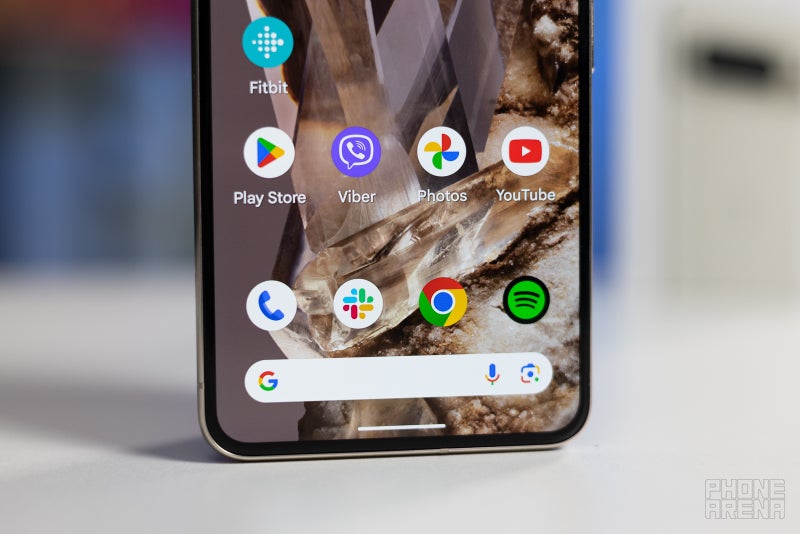














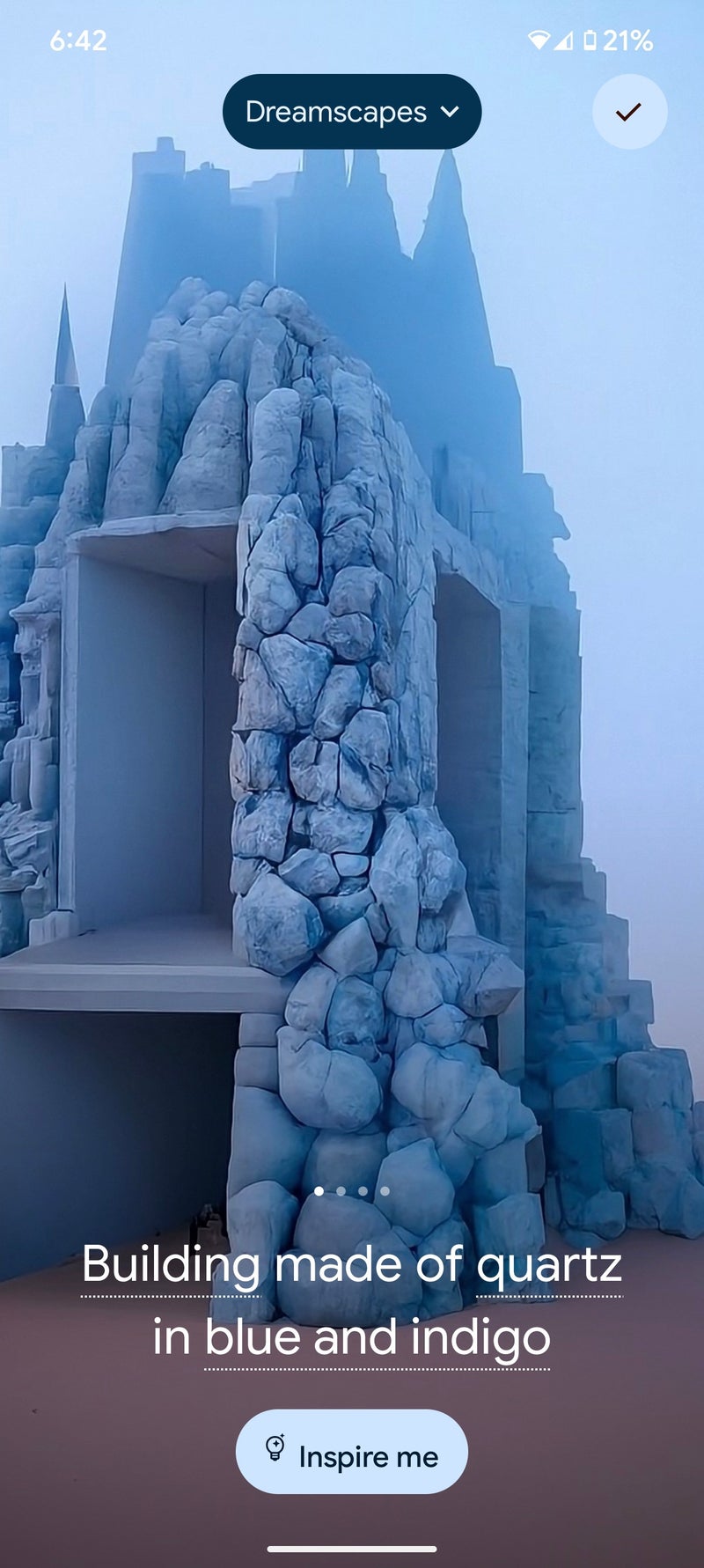

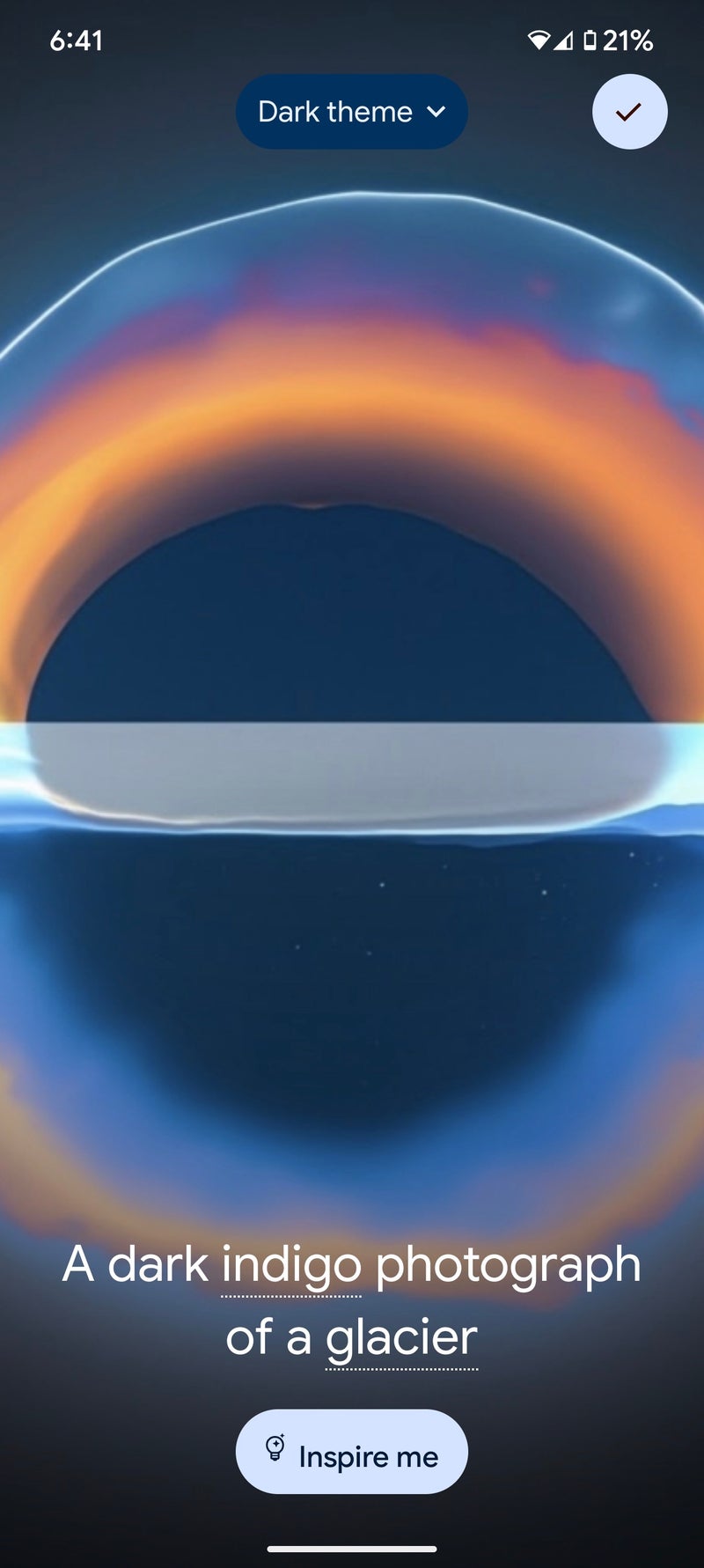













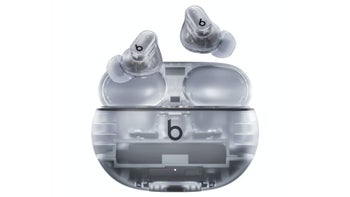






Things that are NOT allowed: